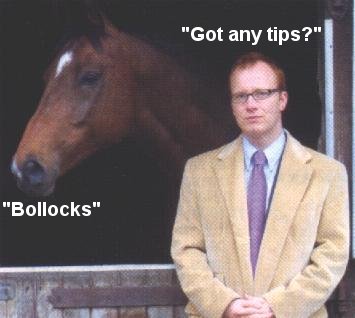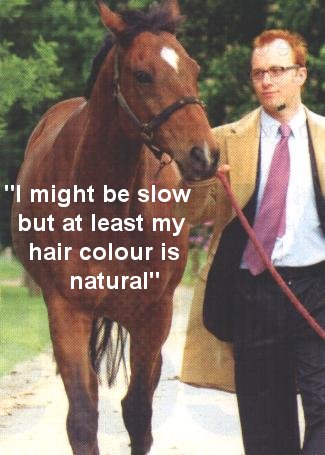

"What you are about
to see will send shock waves through the sport" - Do me a favour !
 Given
the publicity that this "shocking" programme had received in the weeks
prior to it actually being broadcast, I tuned into it with some interest.
After watching it, the only thing remotely shocking about it was the fact
that Paul Kenyon only managed to find three trainers that are on the fiddle.
Anyone who has been punting for any length of time could have provided
him with a list. Given
the publicity that this "shocking" programme had received in the weeks
prior to it actually being broadcast, I tuned into it with some interest.
After watching it, the only thing remotely shocking about it was the fact
that Paul Kenyon only managed to find three trainers that are on the fiddle.
Anyone who has been punting for any length of time could have provided
him with a list.
In fact, the two trainers
who I believe to be the finest exponents of the art of manipulating a horse's
handicap mark weren't even mentioned. I hadn't better mention them
here, all I'll say is that they are a lot richer, powerful and more famous
than the three that were featured.
For those of you that
are naive and/or stupid enough (delete as appropriate) to believe that
every horse in every race is allowed to run completely on it's merits,
there are two golden rules that every punter should remember when he or
she places a bet on a horse:
Rule number 1 - "Trainers
don't run their horses for your benefit".
Rule number 2 - "You
don't have to have a bet"
Regarding rule 1 -
It's the racehorse owners that keep trainers in business, not punters.
A trainer doesn't care whether you back his horse or someone else's.
He works for the owner, and if the owner wants his horse targeted towards
a particular race for the purpose of landing a gamble, then the horse will
be trained to peak on that specific day, and therefore won't be fully "wound
up" for any prep races which he may run in prior to that. They're
obviously not going to make this information available to the betting public
so as not to shorten the price up on the big day. You may not like
it, but that's the way it is and the way it's always been. If you've
followed racing for a few years you can sometimes spot horses that are
being laid out for future gambles and use the information to your advantage.
 As
an example, about five years ago, I noticed a handicapper whose best trip
was 2 miles, and whose minimum effective trip was 1m6f, but he was running
in a 1m2f race. Predictably he was hopelessly outpaced and well beaten
without having a very hard race. Over the next few weeks he ran twice
more in similar races with the same outcome. I assumed that he was
being run in such clearly unsuitable races to get his handicap mark reduced
a bit, and thought that when he turned up in a handicap over his right
trip that I would fill my boots. Sure enough he turned up in a 2
mile race at a big Saturday meeting near the foot of the handicap, and
was quoted at 12/1. So with an "I know something you don't know"
grin on my face, I put the money down. Where did he finish? - Absolutely
f*****g nowhere ! As
an example, about five years ago, I noticed a handicapper whose best trip
was 2 miles, and whose minimum effective trip was 1m6f, but he was running
in a 1m2f race. Predictably he was hopelessly outpaced and well beaten
without having a very hard race. Over the next few weeks he ran twice
more in similar races with the same outcome. I assumed that he was
being run in such clearly unsuitable races to get his handicap mark reduced
a bit, and thought that when he turned up in a handicap over his right
trip that I would fill my boots. Sure enough he turned up in a 2
mile race at a big Saturday meeting near the foot of the handicap, and
was quoted at 12/1. So with an "I know something you don't know"
grin on my face, I put the money down. Where did he finish? - Absolutely
f*****g nowhere !
Alright, so I did
my money, but I still believe to this day that he'd been laid out to win,
and was only prevented from doing so by chronic lack of ability.
I haven't named the horse in question as that would be inappropriate and
probably libellous, even though the chance that the trainer concerned (or
any other trainer for that matter) actually reads this site is fairly remote.
One horse that I will
name though is the one featured in "Kenyon Confronts" - Seattle Alley.
If Mr Kenyon had bothered to do his research properly, he would have discovered
that Seattle Alley is something of a course specialist at Hereford, and
should have smelt a rat when Dave Wintle supposedly laid him out to win
at Uttoxeter. He has won 5 races under national hunt rules, and 3
of those were at Hereford, and the times he has been beaten there he has
run creditably. Whereas he'd run 3 times at Uttoxeter prior to the
race featured in Kenyon Confronts and not even been placed. Surely
if he was going to lay him out anywhere it would have been Hereford.
To illustrate this point, on November 14 2000, Seattle alley won a class
G hurdle at Hereford in good style, then nine days after that he ran in
another class G hurdle at Uttoxeter and was 8th of 11 beaten 36 lengths.
Then five days after that on 28 November 2000 he ran again at Hereford
in yet another class G hurdle and again won easily. Do you see a
pattern emerging here? I remember the second win very well because
I was at Hereford that day and backed Seattle Alley on account of his previous
good form there. He paid 5/1 with the bookies, but I backed him on
the Tote and he paid over 10/1, to the extreme annoyance of those that
had backed him in the ring.
When you are attempting
to find the winner of any race, the fact that several of them won't be
fully fit and therefore have absolutely no chance of winning is just another
of the many factors that you have to consider. Paul Kenyon didn't
even mention the fact that in interviews after televised races, top trainers
regularly say things like "he needed the race", or "he was only about 80%
fit today", and nobody bats an eyelid. The horses in question may
have been running on their merits, but unknown to the punting public, they
still had very little chance of winning. How is that any less serious
than what messrs. Wintle, Murphy and Osborne were allegedly doing?
To my mind it's a lot worse, because these are the type of horses that
a lot of punters back, as opposed to the selling platers running at minor
meetings that were featured in the programme.
 Regarding
rule 2 - As far as I can remember, no racecourse bookmaker has ever forced
me to have a bet, I've never been dragged kicking and screaming into a
betting shop and forced to empty the contents of my pockets on the counter,
and no bookmaker that I've got a credit account with has ever phoned me
up and asked me to bet. We bet of our own free will, we have access
to more information now than we have ever had. You can look up any
horse's lifetime form and future entries on the racing post website, you
can establish it's best distance, going preference and what course or type
of course it prefers, so spotting if a horse is running in an unsuitable
race isn't really that difficult. Regarding
rule 2 - As far as I can remember, no racecourse bookmaker has ever forced
me to have a bet, I've never been dragged kicking and screaming into a
betting shop and forced to empty the contents of my pockets on the counter,
and no bookmaker that I've got a credit account with has ever phoned me
up and asked me to bet. We bet of our own free will, we have access
to more information now than we have ever had. You can look up any
horse's lifetime form and future entries on the racing post website, you
can establish it's best distance, going preference and what course or type
of course it prefers, so spotting if a horse is running in an unsuitable
race isn't really that difficult.
I personally think
that the whole thing has been blown up out of all proportion, given that
the number of horses that run each year must be getting on for 50,000,
and the small number of non triers (those deemed to have been deliberately
prevented from running on their merits) is only a tiny proportion of that
number.
While Paul Kenyon may
have meant well and had the interests of long suffering and incompetent
punters such as yours truly at heart, I can't help feeling that the whole
thing was a big waste of time. Let's face it, everyone outside racing
believes the sport is bent anyway, and those inside know it and don't care,
so what did it achieve?, apart from him getting his mug on TV for half
an hour. Though if I was him, I wouldn't have let the "please don't
hit me Mr Wintle" bit be shown. For those that missed the programme,
after confronting him with the "facts" outside the owners and trainers
bar at Stratford racecourse, Mr Kenyon was wrestled to the ground by Dave
Wintle, a bloke not exactly in top physical condition who is getting on
for twice his age - embarrassing or what?
|